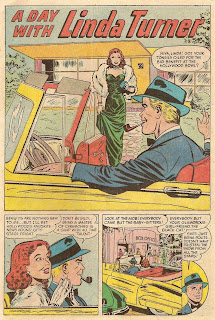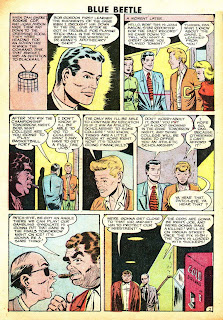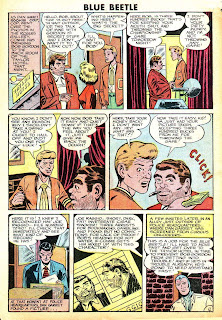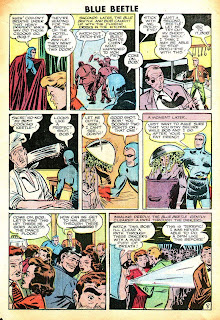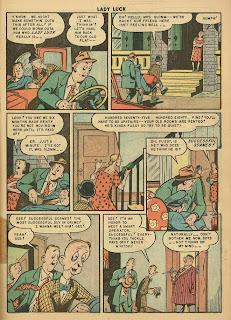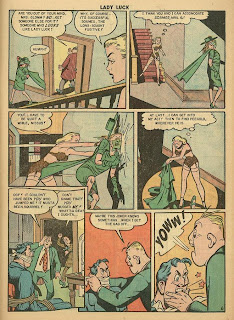Today's stories come from the string of companies commonly referred to as "Centaur Comics". First up is
The Fantom of The Fair from "Amazing Mystery Funnies volume 2 # 7" (July 1939). Next is
The Arrow from "Fantoman # 2" (August 1940), which is also probably reprinted from an early issue of Funny Pages. The first appearance of
The Clock is from "Funny Picture Stories # 1" (November 1936). Last but not least, it's
The Masked Marvel from "Keen Detective Funnies # 24" (September 1940).































"Centaur Comics" has quite a history to it. If you're a fan of the books and characters, I'm sure you've read the story: William Cook & John Mahon took features from Major Malcolm Wheeler-Nicholson and published "The Comics Magazine # 1" with a cover date of "May 1936". On the Who's Who of American Comic Books site, it's mentioned that Everett "Busy" Arnold "Printed COMICS MAGAZINE COMPANY comics for Cook and Mahon c1935", which was when he was working at Greater Buffalo Press as vice-president. The date of "1935" seems a little off, but it's better than the usual "financial or other, unspecified help" that I usually see all over the place.
It's well known among fans of the books that "Dr Mystic" was simply a retitled "Dr Occult" story, the first part of a continued tale that wouldn't be picked-up again by The Major's books until "More Fun Comics v2 n2" (October 1936). What's usually left-out of this picture is that Dr Occult had two stories published ("The Metheuselah Murders" in May '36 and in July-September 1936, "The Werewolf" Parts 1-3) in-between his appearance in CMC's "Comics Magazine" and the October issue of "More Fun Comics". I have a hard time believing that Jerry Siegel & Joe Shuster, the creators of Dr Occult, would work out of order like that, so I'm left wondering if The Major ever had plans to publish the entire story started in "The Comics Magazine".
Also ignored is the fact that not only did Mahon & Cook get "inventory" from The Major, but he may have given them two features to call their own, as well. Both "Dickie Duck" & "Freddie Bell" appeared in National's "New Comics" #'s 1-3 (Dec 1935-Feb 1936), and then continued to run in CMC's books from "The Comics Magazine # 1" until issue 11, at which point that series had been retitled "Funny Pages" (Dickie Duck would make another appearance in Star Comics v2 n2). Both features were drawn by Matt Curzon (originally Nathan Kurtzon, if I can believe anything I ever read on the internet), who went on to create "Pixie Puzzle Adventures", which ran from 1948 to '56 in New York Herald-Tribune Sunday comics section. Ok, so maybe The Major didn't give Mahon & Cook the two features, maybe Curzon decided to work CMC instead of National, but 70-some years later, who really knows what the heck was going-on there?
The Clock is the first masked hero to originate in a comic book, although masked heroes weren't anything new, what with Zorro, The Lone Ranger, The Green Hornet, Lee Falk's The Phantom and a number of pulp heroes appearing before The Clock. Created by George Brenner, The Clock would appear in CMC's Funny Pages, Funny Picture Stories and Detective Picture Stories before being taken to Feature Funnies (eventually Feature Comics) and then Crack Comics, published by Quality Comics. Two of The Clock's appearances would be reprinted under the title "Alias the Clock", which ran in Keen Detective Funnies vol 1 #'s 8 & 9 (Sept-Oct 1938), published by CMC's successor, Centaur Publications.
The transition from Mahon & Cook's Comics Magazine Company to Centaur Publications involves Frank Temerson's Ultem Publications and Harry A Chesler's two titles, "Star Comics" & "Star Ranger". Ultem Publications would become the publisher of "Star Comics", "Star Ranger", "Funny Pages" and "Funny Picture Stories" starting with cover dates of September & October 1937. Nearly everything Mahon & Cook had included in their books was chucked out the window to make room for Chesler's features. Gone were Matt Curzon's Dickie Duck & Freddie Bell, The Red Avenger by Ellis Edwards, Victor Dowling's Sights About Town, Martin Filchock's CC Kid & Windy, George Brenner's Clock and J.A. Patterson's Learn Cartooning. Replacing all of that was the work of Dick Ryan, Ken Fitch, Fred Guardineer, Frank Frollo and the rest of Chesler's crew.
Whatever the reality is of why Ultem picked-up these four titles for only a short time, the end result is that all four of these books were acquired by "Centaur Publications", which began publishing the books starting with cover dates of "March 1938". From this point forward, most of "Centaur Comics" more popular features began appearing. Paul Gustavson was the creator of both The Arrow & The Fantom of the Fair. The Arrow debuted with a cover date of "September 1938", shortly after Superman showed-up in "Action Comics # 1". The Fantom arrived almost a year later with a cover date of "July 1939", the same month that The Masked Marvel debuted with a story by Ben Thompson.
I'll get back to "Centaur Comics" again sometime, continuing to flesh-out that story. It's a work-in-progress, really, since most "comic historians" ignore anything that doesn't appear in a comic book format. There was more going-on there than most people realize.
